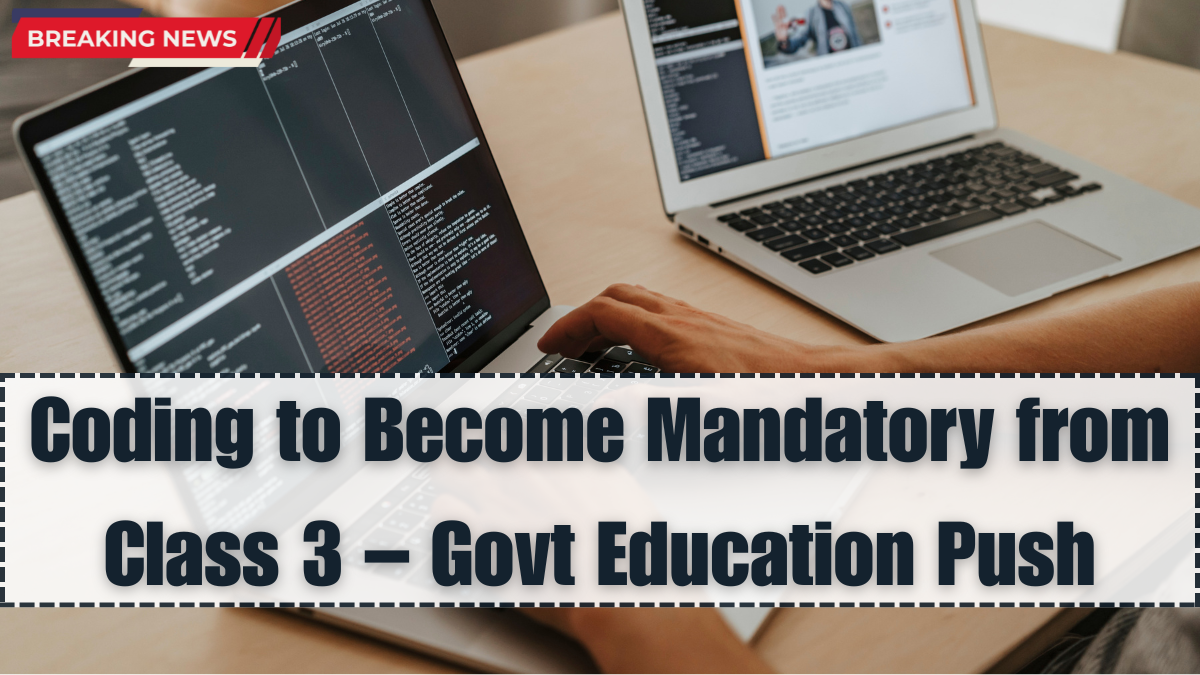In a major reform under the Digital India education strategy, the Government of India has declared coding mandatory in schools from Class 3 onwards starting from the 2025 academic year. This landmark policy move underlines India’s commitment to creating a digitally empowered generation with future-ready skills right from the foundational level.
The policy titled Coding for Primary Classes aims to integrate basic programming, logic building, and computational thinking into the national school curriculum. By starting early, the government envisions an education system that nurtures creativity, analytical thinking, and digital fluency from the ground up.

Objective Behind the Digital Education Mandate
The Coding for Primary Classes initiative is part of the larger National Education Policy (NEP) 2020 and the Digital India mission, both of which emphasize the role of technology in transforming education. The goal is to move beyond textbook learning and help students become creators of technology rather than passive consumers.
Key objectives of the policy include:
-
Introduce problem-solving and logic-building skills from an early age
-
Prepare students for tech-driven careers by the time they complete school
-
Encourage creativity, innovation, and design thinking
-
Promote gender inclusivity in technology education
-
Ensure India’s youth are equipped for AI, robotics, and digital ecosystems
With the rollout of Coding for Primary Classes, India joins a global league of nations like the UK, Australia, and Singapore where coding is part of the school syllabus.
Coding Curriculum Structure by Class Level
The National Council of Educational Research and Training (NCERT) and CBSE have designed a progressive, age-appropriate curriculum for the Coding for Primary Classes program. The syllabus is divided into conceptual modules, interactive activities, and project-based assessments.
| Class Level | Coding Concepts Introduced |
|---|---|
| Class 3–5 | Basic logic, flowcharts, pattern recognition |
| Class 6–8 | Block-based programming, game design, animations |
| Class 9–10 | Python, data structures, simple algorithms |
| Class 11–12 | Advanced coding, AI/ML basics, app development |
For Classes 3 to 5, the Coding for Primary Classes module uses fun tools like Scratch, Blockly, and visual storytelling platforms, ensuring children grasp concepts through play-based learning.
Implementation Support for Schools
To make the Coding for Primary Classes policy successful nationwide, the Ministry of Education has developed a structured plan for implementation, teacher training, and resource distribution. Both government and private schools are required to comply with the new coding mandate.
Support measures include:
-
Free access to digital learning platforms and software tools
-
Teacher training workshops at state and district levels
-
Partnerships with ed-tech firms to provide hands-on coding kits
-
Multilingual curriculum available in Hindi, English, and regional languages
-
Preloaded content on Diksha, ePathshala, and PM eVidya portals
The Coding for Primary Classes rollout is being phased in to ensure every school is fully prepared by the start of the 2025–26 academic year.
Benefits of Early Coding Education
Educational experts and child development professionals have praised the Coding for Primary Classes mandate as a much-needed reform. Starting coding at an early stage helps enhance cognitive flexibility and improves academic performance in other subjects as well.
Key benefits include:
-
Develops logical and analytical thinking from a young age
-
Boosts confidence and self-expression through creative projects
-
Increases awareness of digital safety and online ethics
-
Prepares students for 21st-century career opportunities
-
Builds strong foundations for STEM education and innovation
By integrating coding into the core curriculum, the Coding for Primary Classes initiative ensures that students from all backgrounds have equal access to technology education.
FAQs
What is the Coding for Primary Classes policy?
The Coding for Primary Classes policy mandates the inclusion of coding and computational thinking in the national school curriculum starting from Class 3 from the 2025 academic year.
Which subjects will include coding?
Coding will be introduced as part of the ICT (Information and Communication Technology) curriculum and integrated with other subjects like math and science.
Are schools prepared to teach coding?
The government is providing digital tools, training modules, and coding kits to help schools implement the Coding for Primary Classes policy effectively.
Will coding be part of exams?
In the initial years, Coding for Primary Classes will be assessed through projects and activities, not formal exams.
What coding platforms will be used for primary students?
Visual tools like Scratch, Blockly, Code.org, and other age-appropriate platforms will be used under the Coding for Primary Classes initiative.
Click here to know more.
